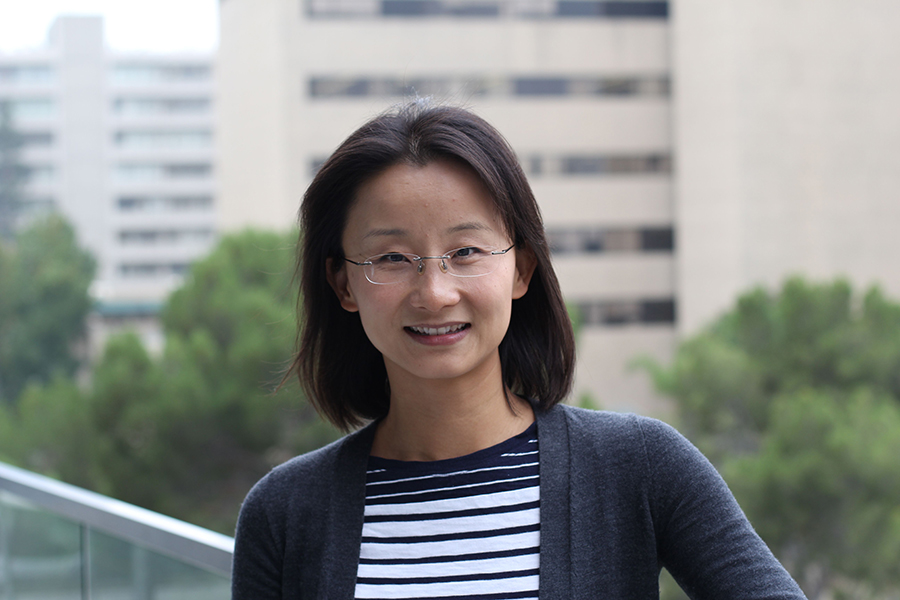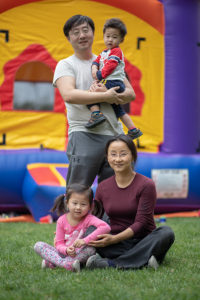
When Rong Lu joined USC as an assistant professor of stem cell biology and regenerative medicine in 2014, she knew that earning tenure would figuratively require blood, sweat and tears. But after becoming a mother, she ended up literally supplying her children’s cord blood to her lab to study how individual stem cells work together to maintain a healthy blood supply and immune system, and how to improve bone marrow transplantation for patients with cancer and other diseases.
“I sent the cord blood of my children to my lab, and used it for a couple of projects. Because the samples were so fresh, they have been the best so far for studying human blood stem cells,” said Lu, who was recently awarded tenure and promoted to associate professor of stem cell biology and regenerative medicine, biomedical engineering, medicine, and gerontology at USC.
Lu approaches her work as a labor of love and doesn’t take for granted the opportunity to pursue her chosen career. Her parents grew up during China’s Cultural Revolution, which cut off their educations after primary school and prevented her mother from pursuing her dream of becoming a doctor. Her parents were sent to work for a government-run petrol oil factory in the town of Liaohua in Liaoning Province in northeast China, where Lu was born and raised.
Lu earned her bachelor’s degree in biology from Lanzhou University, studied English for a year, and then pursued her PhD in molecular biology at Princeton University, where she began working with stem cells.
At Princeton, she also met her husband, a PhD student in physics who was studying the neuroscience of goldfish in an adjacent lab.
She went on to do her postdoctoral training in the lab of Irving Weissman at Stanford University, where she developed a technology for using genetic markers to “barcode” individual blood stem cells, allowing her to individually track their behavior, interactions and contributions to blood.
New beginnings at USC
Lu’s first 9 months at USC were extremely eventful.
“The first thing that happened when I arrived at USC was I found out that I was pregnant,” she said.
Knowing that she and her husband would soon be welcoming their first child, she quickly set to work: spending her weekdays setting up her lab, and her weekends house hunting in Pasadena—a neighborhood that was close to USC and also familiar to her husband, who had earned his undergraduate degree from Caltech and who now runs a company specializing in computer games.
“I was trying to train my graduate students and my lab manager before I had to go on maternity leave, and we started with an empty lab and a whole storage room of equipment and supplies to unpack,” she said. “That was quite a busy and fun time. I’m lucky to have great students and personnel, who were very supportive and hardworking in collecting data while we were building the lab.”
Meanwhile, the chair of her department, Andy McMahon, had a well-established lab adjacent to hers, and was happy to lend her the supplies to help get her lab running quickly.
Two weeks after her daughter was born, Lu was already back in the lab half-a-day a week. She gradually increased her time in the lab, and 8 weeks after becoming a new mom, she was back to work full-time. Her retired parents flew in from China for a year-long visit to help care for the new baby.
She began writing grant proposals, and quickly secured two NIH Research Project Grants, also known as R01s. In May 2016, the lab published its first major paper in the journal Cell Reports, describing how individual blood stem cells alter their behavior in response to the donor cell dose in bone marrow transplants.

Not long thereafter, she found out that she was pregnant again—this time with a son, who was born in March 2017.
“When the second child comes in, the family dynamic is different, because we then have to play one-on-one as we have two adults and two kids,” she said. “So basically, my husband took care of the older one, and I was with the baby in my bedroom. I didn’t have help from my parents that time, so I basically had to be with the baby 24-7. He slept, I slept. He needed to eat, I fed him. It was a pretty enjoyable time to be with the little ones.
Her lab continued publishing paradigm-shifting research about the complex and surprising behavior of individual blood stem cells, and secured a $6.6 million NIH Emerging Investigator Award, also known as an R35. This grant provides 7 years of stable funding, which freed up her lab to invest in ambitious, creative and risky research projects.
“I started my lab with two specific questions in mind: how individual stem cells are different from each other, and how different stem cells work together,” said Lu, who is also a Leukemia & Lymphoma Society Scholar. “My lab has been working on these two questions over the past few years and will continue working on them in the future. USC has a very collegial culture and lots of brilliant collaborators. So we’ve been able to generate new ideas and new approaches to address these questions by working with wonderful colleagues. I’ve had some surprisingly rewarding experiences working on projects that I didn’t plan for—for example, I never thought that I would be culturing hematopoietic stem cells in vitro, but that is what we are doing in a collaboration with Dr. Keyue Shen from USC’s Department of Biomedical Engineering. Research also evolves. We have realized that to understand cellular coordination, we have to learn about cells’ spatial interactions in the bone marrow. A very important collaborator of ours right now, Dr. Michael Elowitz at Caltech, has this amazing dynamic barcoding system that allows us to read cellular lineage relationships from a spatial perspective.”
Lu also serves as the faculty director of the Flow Cytometry Facility, located in the Eli and Edythe Broad CIRM Center for Regenerative Medicine and Stem Cell Research at USC. The facility provides researchers across Southern California with state-of-the-art technology to isolate and characterize specific populations of cells.
She evaluates grant applications as a standing member of the NIH study section on the Basic Biology of Blood, Heart and Vasculature (BBHV), composed of leading scientists in the field.
In addition, Lu has enjoyed developing a new elective course about blood stem cells for the master’s program in stem cell biology and regenerative medicine.
More recently, when the pandemic disrupted schools, she found herself creating curriculum for her own children, who are now ages four and seven.
“My husband is in charge of their math, reading and sports, and I teach them harp and painting,” said Lu, who plays a four-stringed Chinese lute called a pipa and learned to paint with Chinese inks from her father.
Even though her life only gets busier with each passing year, Lu wouldn’t have it any other way.
“First of all, studying science is fun; finding something new is fun; learning new things is fun. It’s something I really enjoy,” she said. “And secondly, I truly believe in science and education. I think that they are the most important things for human societies, and I’m lucky enough to be able to do both. So I really enjoy what I’m doing, and hopefully, I can contribute something useful.”
